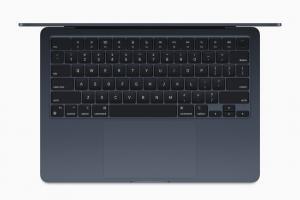Many Mac users who are either bilingual or learning another language may need to type the upside-down question mark.
The inverted question mark punctuation is found in Spanish as well as some other languages, and so if you’re either typing in another language or just need access to that punctuation, you certainly aren’t alone in wondering how to type the inverted question mark in macOS.
In this article, we’ll teach you five easy ways to type Inverted Question Mark on your Mac.
Without any further ado, let’s get started.
QUICK ANSWER
To type an upside question mark (¿) symbol on Mac, press Option, Shift, and the Question Mark keys on your keyboard. In other words, it’s the same as typing a regular question mark but with the addition of the Option key.
Continue reading to better understand how to type this symbol on Mac using the keyboard and other methods.
How to type upside down question mark on Mac
1. Use a keyboard shortcut

The easiest way to type an upside-down question mark on a Mac is to use the keyboard shortcut. Here’s how:
- Move your cursor to the point where you want the punctuation.
- Press the following keys: Option Shift ?
This shortcut is pretty easy to remember. Essentially, you just have to add the Option key when you want the question mark to be upside-down rather than right-side-up.
2. Use the Character Viewer to insert Inverted Question Mark on Mac
You can use the Character Viewer to insert the inverted question mark to text on your Mac. Here’s how:
- Press Control-Command-Space bar or press the fn key with the globe symbol in your keyboard’s lower-left corner. This will bring up a popup window with emojis and symbols.
- Type the word question in the search field at the top, and the upside-down question mark symbol will appear.
- Click the inverted question mark symbol to insert it in the text.
3. Use a Spanish language keyboard
If you’re using a Spanish keyboard, then you already have the upside down question mark as a key. However, if you don’t have this on your keyboard, you can add a Spanish language keyboard to your Mac. Here’s how:
- On your Mac, choose Apple menu > System Settings.
- Click Keyboard in the sidebar.
- Go to Text Input on the right, then click Edit.
- Click the Add button then search for Spanish.
- Click Add
- Turn on or select the checkbox next to “Show Input menu in menu bar.”
- To switch to the other keyboard, click the Input menu on the right side of the menu bar, then choose a keyboard.
4. Adding Inverted Question Mark In HTML/CSS
If you are a developer, you can add inverted question mark in HTML and CSS using entities.
HTML and CSS entities are special codes used to represent characters that have special meanings or cannot be displayed as regular text in HTML and CSS.
Entities are used to display characters such as angle brackets, ampersands, and quotation marks, as well as special symbols such as copyright, trademark, and multiplication signs.
Using entity codes is important for ensuring that HTML and CSS code is valid and can be interpreted correctly by web browsers.
The HTML code for the Inverted Question Mark is ¿
The CSS code for the Inverted Question Mark is \00BF
To add the Inverted Question Mark to an HTML page, you can use its entity name or number (decimal or hexadecimal reference), as shown in the example below:
// html example
<span> ¿ </span>
To display the Inverted Question Mark from CSS, you can use a CSS shortcode or CSS entity, as shown in the example below:
// css example
span {
content: "// css example
span {
content: "\00BF";
}
BF";
}
5. Copy and paste an upside down question mark for an easy solution.
The easiest way to get the Inverted Question Mark on Mac is to copy and paste it wherever you need it. Here’s how:
Use your mouse to highlight the inverted question mark symbol provided below.
¿
Now, use Command C to copy it to your clipboard.
Head back to the document that you’d like to type in, then hit Command V to paste it. This is a hassle-free method for typing inverted question marks on Mac.
FAQs
What is the upside-down question mark used for?
The inverted question mark (¿) is written at the start of questions or an interrogative clause or sentence. It indicates that a question is coming. It is a rotated form of the standard question mark (?) and is usually written in Spanish and other scripts related to Spanish. The upside-down question mark is placed at the beginning of the sentence, and a regular question mark is placed at the end. For example, ¿Te gusta el verano? = Do you like summer?
What is the upside-down question mark called?
The upside-down question mark is also referred to as the inverted question mark. In Spanish, the “inverted question mark” (¿) is called “el signo de la interrogación invertido”.
Is the upside-down question mark inserted using character viewer the same as the one inserted by the keyboard?
Yes, the two characters are exactly the same even though the methods of inserting it into the text are different.
Conclusion
Most people have difficulty typing or inserting inverted question mark symbol on Mac. So, we’ve broken down the various methods and steps required to type or get it into your text.
And as you can see above, we’ve attempted to cover as much information about the Inverted Question Mark as possible.
Thank you for reading. If you have any other questions about this symbol, drop a comment and let us know.
